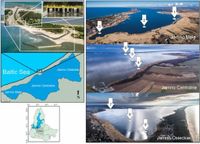A recent study published in Scientific Reports has shed light on the environmental impact of blocking seawater intrusion on Lake Jamno, located on the southern Baltic Sea coast. Over a period from 2010 to 2020, researchers assessed the changes in the assemblages of Chironomidae larvae, crucial indicators of aquatic ecosystem health, before and after the construction of storm surge barriers.
Lake Jamno, a coastal lagoon historically connected to the Baltic Sea, underwent significant transformations following the installation of floodgates on November 4, 2013, which aimed to provide flood protection and improve fishing efficiency. However, these modifications have disrupted the hydrological connectivity vital for the ecological balance of coastal ecosystems. The study's findings highlight that this intervention has led to a permanent shift in the lake’s saline conditions to primarily freshwater, adversely affecting the biodiversity and overall health of the larval communities.
During the research, the team observed that the alpha-diversity of the Chironomidae larvae decreased significantly after the barriers were activated, with the density dropping by over 20%. In the last year assessed, only two genera, Chironomus sp. and Procladius sp., were found, indicating a loss of species and an alarming decline in ecological quality. Prior to the barriers' activation, the lake was characterized by a diverse community of benthic invertebrates, which serve vital roles within aquatic food webs.
The study not only underscores the importance of periodic seawater intrusion for maintaining ecological dynamics but also serves as a critical reminder of human interventions that can induce irreversible changes. The research, led by authors including N. Mrozińska and K. Glińska-Lewczuk, emphasizes that such alterations in salinity have cascading effects, influencing not only Chironomidae larvae but the entire benthic community structure.
Lake Jamno, covering 22.07 square kilometers and averaging 1.7 meters in depth, was selected for this long-term study due to its unique hydrological conditions and sensitivity to environmental changes. Over four years of field studies, researchers collected macrozoobenthos samples across nine sites during the summer peak periods. The results clearly indicated significant impacts of the seawater blockade on both the density and diversity of Chironomidae larval assemblages.
The analysis revealed that the blockage of seawater intrusion altered vital environmental parameters within the lake. Factors like electrical conductivity (EC), temperature, and nutrient concentrations showed significant differences between pre-barrier (FF) and post-barrier (BF) conditions, reinforcing the idea that human-induced modifications have profound effects on ecosystem health. These observations align with the belief that Chironomidae serve as excellent bioindicators of changes in freshwater systems.
In light of the findings, the authors assert, “Continuous monitoring and assessment are critical in coastal ecosystems to mitigate the effects of human interventions.” The results indicate that the lack of periodic saline input has not just reduced the diversity of Chironomidae larvae but has also restricted their adaptability to changing environments.
As the study emphasizes the delicate balance within coastal lagoons, it opens a broader discussion on the management and conservation of such vital ecosystems. Understanding how hydrological connectivity influences the dynamics of aquatic organisms is crucial for future conservation efforts.
The long-term data presented in this study provides invaluable insights that can inform policies aimed at preserving the ecological integrity of coastal lagoons not only in the Baltic region but globally. This research further highlights the threats posed by climate change and anthropogenic interventions, urging for sustainable strategies to maintain these precious environments.
While the study focused specifically on Lake Jamno, its implications resonate beyond local boundaries, serving as a cautionary tale regarding the impacts of habitat modification on biodiversity. As environmental pressures mount, the lessons learned from this research could guide future efforts to balance human needs with ecological sustainability.

